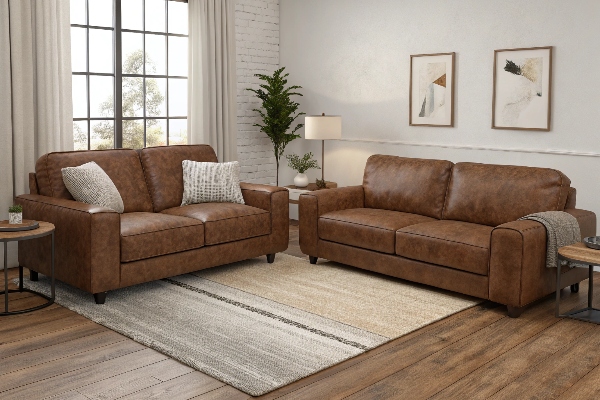Faux leather looks great and costs less. Yet many friends later feel stuck with cracks and flakes. I have seen their shock. Let me spare you the same fate.
Faux leather furniture often peels, cracks, and fades within three to five years. It traps heat, feels less breathable than real hide, and is hard to mend. These limits cut comfort, looks, and resale value.

I once bought a glossy faux leather chair for a guest room. It shone for one season, then the surface turned dry like onion skin. The flakes stuck to clothes. I learned to check the hidden costs, not just the ticket price.
Is Faux Leather Good Quality for Furniture?
That showroom shine can fool any of us. I fell for it more than once. The true test shows up after daily use, not under store lights.
Faux leather quality sits below real leather because the surface is a thin plastic film over fabric. It cannot heal scratches, breathe well, or age with grace. Look for high-grade PU or microfiber if you must choose faux.

What Makes “Quality” in Faux Leather?
| Factor | Real Impact in Daily Use | My Field Notes |
|---|---|---|
| Coating thickness | Thicker film delays cracks, but feels stiff | Aim for 0.15 mm+ PU if kids jump on sofas |
| Base fabric | Tight microfiber holds the film better | Woven polyester lasts longer than knit |
| Plasticizer type | Low-VOC stays flexible longer | Ask for DINP-free to cut smell |
| Top finish | Matte hides scuffs; gloss shows every mark | I touch samples with a key before buying |
Still, even the best synthetic layer cannot self-repair like hide. Once a cat claw breaks the film, moisture sneaks in, and the tear grows. If clients insist on faux, I suggest darker colors and slipcovers for high-traffic rooms.
What Can Ruin Faux Leather?
Spilled nail polish remover, sharp buckles, and dry heat vents all attack faux leather faster than you expect. I lost a car seat cover to a single summer road trip.
Faux leather breaks down when solvents, UV rays, or sharp stress cut the plastic topcoat. Use mild soap, keep it out of direct sun, and trim pet nails to slow the damage.

Main Enemies and How They Strike
| Enemy | How It Acts | Simple Fix |
|---|---|---|
| Direct sunlight | UV embrittles plastic; colors fade | Place away from windows or add sheer curtains |
| Body oils & sweat | Acidic oils dissolve finish | Wipe weekly with damp cloth |
| Alcohol cleaners | Strip plasticizers fast | Use water-based wipes only |
| Heaters & vents | Dry heat cracks surface | Keep 30 cm distance from vents |
| Pets | Claws puncture film | Provide scratch pads nearby |
I tell clients to treat faux leather like a delicate coat of paint. Gentle care slows the clock, but it can never turn back the chemical aging inside the material.
How Long Will a Faux Leather Sofa Last?
A fresh faux leather sofa may hold its form for the first couple of years. The real countdown starts with the first crease you sit on daily.
Most mid-grade faux leather sofas last three to five years with normal family use. Top-tier microfiber PU might stretch to seven. Real leather often doubles that span, which offsets its higher cost.

Years Versus Usage: A Realistic Timeline
| Year | Visible Change | Comfort Change | What I Advise |
|---|---|---|---|
| 0–1 | Looks pristine | Firm cushions | Rotate cushions monthly |
| 2–3 | Minor wrinkles | Slightly warmer feel | Clean every 2 weeks |
| 4–5 | Peeling at edges | Sticky in heat | Consider slipcovers |
| 6–7 | Large cracks | Foam exposed | Budget for replacement |
One client in Dubai kept her faux set in an air-conditioned lounge and stretched its life to six years. Another in humid Manila saw peeling within two. Climate, care, and usage set the clock.
What Are the Cons of Faux Leather?
Faux leather seems like a bargain, but the hidden trade-offs pile up. I learned these the hard way while sourcing materials for hotels.
Key cons include shorter life, low breathability, poor repair options, and environmental waste from PVC or PU coatings. Disposal is tricky because the mixed materials block recycling.

Quick Look at Drawbacks
| Con | Why It Matters | Real Example |
|---|---|---|
| Peeling surface | Ruins looks fast | Lobby sofa shed flakes onto guests’ suits |
| Heat build-up | Feels sticky in summer | Gym benches got sweaty within minutes |
| No patina | Cannot age gracefully | Vintage café theme failed with plastic shine |
| Landfill impact | Non-biodegradable | 200 rooms of old headboards filled a truck |
When a hotel chain asked me to replace their cracked faux headboards, transport and waste fees cost more than the new covers. They switched to a durable bio-based PU that met green codes and lasted longer.
Conclusion
Faux leather saves cash up front, but shorter life, easy damage, and waste risks often erase those savings within a few short years. Weigh care needs and long-term costs before choosing.
